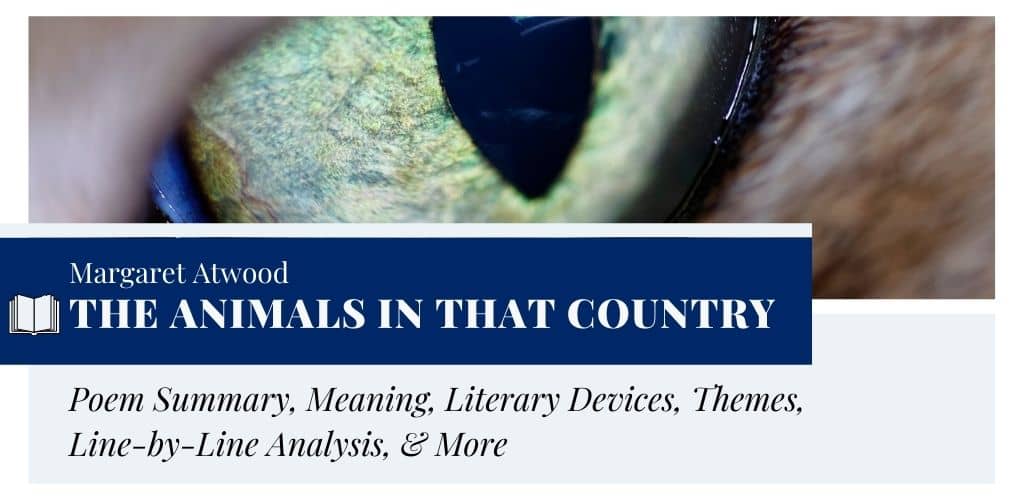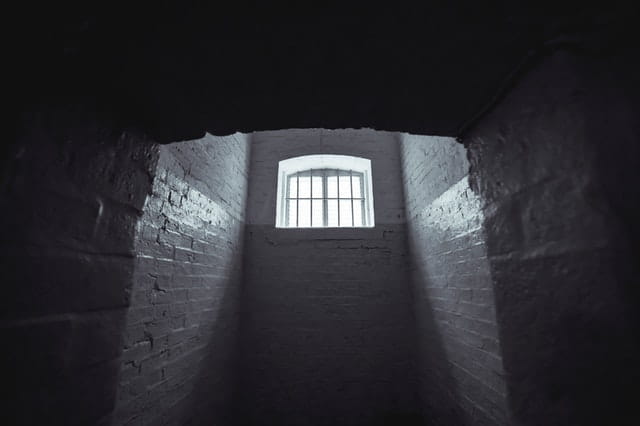The animals in that country by Margaret Atwood
“The animals in that country” is an interesting poem that sheds light on the history of Canada from the perspective of a native inhabitant. Margaret Atwood wrote several works resorting to the metaphor of animals. Sometimes, she highlights the politics of power by using animals as a symbol. While, in some cases, she portrays animals as a manifestation of settlers who wiped the indigenous culture of Canada after settlement. In this piece, she satirizes the settlers and showcases how they are no different than the actual animals with hideous instincts. The poem appears in Atwood’s poetry collection by the same title.
- Read the full text of “The animals in that country“

Summary
“The animals in that country” is an ironic representation of settlers who are depicted as animals. Atwood’s persona refers to a number of animals including “ceremonial cats”, fox, bull, and wolves. Each of these animals represents a specific feature of the settlers. Some of them showcase English snobbery and boastfulness. While some creatures represent their inhumane and treacherous side.
The text is clearly divided into two sections. Atwood shows the features of the animals disguised as humans of “that country” (an implicit reference to the European settlers such as colonizers from England, America, France, etc.). She contrasts their human characteristics with the real animals who live in “this country”, a reference to Canada. The contrast is shown clearly by indenting the stanzas after the seventh section.
Meaning
“The animals in that country” is a darkly humorous poem about the difference between the nature of settlers and the natives. Atwood uses the symbol of animals in order to portray individuals with different character traits. For instance, in the first section, the “animals” of “that country” are similar to the people who live there. Whereas, the nature of animals living in “this country” is portrayed as timid and natural. Though the title of the poem specifically hints at the settlers, it is not about them solely. Rather, Atwood tries to create a contrast between the attitude of English settlers and the indigenous people of Canada.
Structure & Form
Margaret Atwood’s “The animals in that country” is a free-verse poem. It means there is no regular rhyme scheme or meter in the text. The structure of lines and the overall poem consists of several elements of modernism. Atwood uses a loose structure that does not contain any regular sentence pattern. The lines are separated into several stanzas without any specific line count. Besides, the last four stanzas are indented from the body of the text in order to mark a transition. It is used to show the shift in the subject matter. The first section consists of a single sentence containing a number of clauses. While the next section contains end-stopped lines.
Poetic Devices
Atwood makes use of the following poetic devices in “The animals in that country”.
- Metaphor: Atwood uses a number of metaphors in the poem. For instance, the “ceremonial cats” are a metaphor of the fashionable and snobbish upper class. Readers can find the use of this device in “tapestry of manners”, “embroidered/ with blood”, “in his blue mouth”, “forests thickened with legend”, etc.
- Personification: In the first section, the animals such as the cats, fox, bull, and wolves of “that country” are personified.
- Enjambment: By using this device, the poet internally connects the lines 1-20. It makes readers quickly go through the lines to grasp the meaning. Besides, it is also used in the next stanzas.
- Irony: It occurs in the very first lines of the poem: “In that country the animals/ have the faces of people”. These lines are followed by another use of irony in the phrase “ceremonial/ cats”.
- Aside: This device is used in the fifth stanza in order to convey why the bull has “heraldic brand” stamped on him.
- Litotes: Atwood uses this device in the lines “Their deaths are not elegant” and “They have the faces of/ no-one”. The use of negatives emphasizes the fact that the animals of the speaker’s country are different than the former’s.
- Alliteration: It is used in “the bull, embroidered/ with blood”, “his name/ stamped on him, heraldic”, “sand, sword”, and “human/ he”.
- Repetition: This device is used in the last few lines of the poem for the sake of emphasis. Here, Atwood repeats the term “their” at the beginning of consecutive sentences.
Themes
The main theme of “The animals in that country” concerns the difference between the European settlers (especially English) and the Canadian natives. There is no clear reference to them but readers can sense the irony in the context of colonial history. Atwood also employs the themes of identity, power, manners and customs, and simplicity. The first section of the poem (Lines 1-20) is all about the attitude of the settlers, their customs, snobbery, showcase of customs, and refinements. The poet shows this sophisticated side of personified animals in order to create a contrast between the indigenous culture of Canada. In the second stanza, she points out that the natives are as humans need to be. There is no refinement. Simplicity reigns among them. After the English settlement, refinement took over simplicity and their apparent wildness. The rest is history!
Line-by-Line Analysis & Explanation
Lines 1-2
In that country …
… faces of people:
Atwood’s poem “The animals in that country” begins with an ironic remark. The speaker of this piece is one of the natives of Canada who expresses her views regarding the settlers. In the first line, “that country” is a reference to England from where most settlers came to the speaker’s country. She specifically describes the animals of that country.
Aren’t humans animals too? But, they are different from the wild ones as they live in society by following several customs that keep them apart from the latter. Besides, they have laws, moral values, ethical codes, and so on that should be followed in order to be called a social animal or human.
But, Atwood refers to the animals in a different sense. She implicitly talks about the settlers by referring to them as “animals”. According to her, they have faces resembling that of humans. It means there is no clear difference between the animals and humans of “that country”. The values which distinguish humans from animals are faded. Hence, she undoubtedly calls them animals but in a roundabout manner.
Lines 3-4
the …
… the streets
In the second stanza, Atwood’s persona refers to cats of that country. They are rather “ceremonial” than normal cats. Cats, in general, are not ceremonial at all. But why does the poet describe them in this manner? It is because the “cats” are a symbol of a group of humans having a specific characteristic. They focus much more than outward things, without pondering about their minds. In the settlers’ country, such people can be seen frequently on the streets.
Besides, cats have some special characteristics including selfishness and sophistication. These attributes aptly apply to the settlers. They were selfish to the indigenous people living in Canada.
Lines 5-8
the fox …
… tapestry of manners
In this stanza, Atwood refers to another animal that has a similar nature to cats. She describes how a fox runs politely to earth. Foxes stealthily roam around the forest. But, this characteristic is not comparable to politeness.
Atwood describes their movement as polite because they actually represent the settlers. Like foxes, they stealthily entered into their land and had their job done. Those settlers are far more dangerous than the real foxes living in that country.
There are huntsmen who rather stand in a peculiar fashion. They are standing around the fox without attacking it. According to the poet, they also show sophistication comparable to their “tapestry of manners”. They try to imitate their ancestors who dexterously captured other regions and planted their imperialist seeds there.
Lines 9-13
the bull, …
… because
In that country, there is a bull that is embroidered with blood and given an elegant tribute after its death. The “bull” is a symbol of their mercenaries. Its body is adorned with the blood of indigenous people. Besides, the creature is given a grand tribute for its contribution to colonizing a new country.
People blew trumpets to honor the bull’s death. Atwood also shows a mark that bears the creature’s heraldry. In this section, the poet does not describe an imaginary animal. She symbolizes the creature as a colonizer who died during his service.
The poet ironically depicts the man as a bull that bears the stamp of its “heraldic brand”. In the next lines, she clarifies why the animals are given such a grand tribute.
Lines 14-17
(when he …
… really a man
According to Atwood’s speaker in “The animals in that country”, the bull did a specific thing that marked it different from other creatures. It rolled like a soldier on the sand with a sword embedded in its heart. While dying, his bare teeth showed his “blue mouth”. It is a symbol of its noble blood. In this way, Atwood does not show an animal. She rather projects one of the English noblemen. If one looked at the creature’s mouth, one could find a stark similarity between its teeth and that of humans. For this reason, in the next line, she emphasizes the fact that the bull is really a man.
The line “he is really a man” can be interpreted differently. In that country, people are wilder than actual animals. So, the poet finds the actual representation of wild animals in the people of that country.
Lines 18-20
even the wolves, …
… with legend.
In the following section of “The animals in that country”, the speaker talks about the wolves. Wolves are regarded as a symbol of wildness, barbarity, and ferocity. The poet implicitly compares them with the settlers. They hold “resonant conversations” in their forests. Their conversations have a similar goal of colonizing different regions.
Like wolves howl before starting their hunt, the settlers also hold such hideous conversations while beginning their venture. According to the poet, this metaphorical “forest” of theirs contains the legends of the past. The legend contains the stories of the powerful subjugating the powerless.
Lines 21-23
In this country …
… animals.
Atwood indents this stanza and the following ones in order to mark a shift in the subject matter. From this section onwards, she starts talking about the animals of her own country. Previously, she has talked about the creatures having human attributes. But, in these lines, she portrays the animals as they are. There is no exaggeration of facts.
Like any other region of the earth, the animals of her country have faces of animals. They show what they really are. Unlike those who wear a face of sophistication in order to hide their animal instincts. Their “faces” are the token of hypocrisy and conspiracy. While the animals of her country show their tie with nature.
Lines 24-26
Their eyes …
… are gone.
In this section, she focuses on their eyes. She uses familiar imagery to bring home the fact that the animals are not that wild as projected by others. They do fear human intervention in their territory. Hence, they try to hide their existence in order to continue their course of life.
She describes how wild animals run away while they come across the headlights of cars. When the light sparkles in their eyes, in a moment, they run away or hide. It is interesting to note that the poet refers to the animals native to her place for portraying them as a symbol of the indigenous people. Like the animals, they do fear foreign invasion. They try hard to hide from the clutches of modernity and carry on as things were.
Lines 27-29
Their deaths are …
… no-one.
In the last three lines of the poem, the poet uses full stops at the end of sentences. These lines sound like facts. She describes what is natural and destined to happen. There is no sophistication while an animal dies. Likewise, her people do not blow trumpets when their keens die. The term “elegant” is used to satirize the style of the settlers.
In the next line, she uses the repetition of the term “faces”. She emphasizes the fact that their faces don’t resemble that of the settlers. It is not about the differences between their external features. Rather, Atwood shows how her ancestors were different in respect to their attitude towards life.
Historical Context
Margaret Atwood’s poem “The animals in that country” appears in the poetry collection by the same title. It was first published in 1968. This collection explores the themes of human behavior, nature, and power politics. The poem also appeared in her well-known poetry collection The Circle Game which was published in 1964. Atwood often cites references to human relationships with animals in her works. In this poem, she interestingly talks about Canadian identity by referring to the animals of the settlers’ country and that of her own land. She contrasts refinement with simplicity in this poem.
Questions & Answers
Margaret Atwood’s “The animals in that country” is about the contrast between the nature of settlers and the indigenous people of Canada. In this piece, Atwood talks about the history of Canada from an indigenous people’s perspective.
This poem taps on a number of themes that include identity, power, refinement vs simplicity, and snobbery.
The poem is set in 20th century Canada. Atwood looks back at the past of her country and talks about the attitude of the English settlers metaphorically.
Similar Poems about Culture & Identity
- “Death of a Young Son by Drowning” by Margaret Atwood — In this poem, Atwood talks about the death of a settler’s son who was trying hard to cope up with a new place.
- “Bora Ring” by Judith Wright — This piece is about the Bora ceremony of indigenous Australians.
- “Crow Testament” by Sherman Alexie — This poem is an ironic representation of the history of Native Americans.
- “I, Too, Sing América” by Julia Alvarez — In this poem, Alvarez describes her American identity from a different perspective.
External Resources
- Check out Selected Poems 1965-1975 by Margaret Atwood — “The animals in that country” also appears in this poetry collection. Explore the best-known poems of Atwood published in the book.
- About The Animals in That Country (1968) — Read about the poetry collection and its themes.
- Colonial History of Canada — Learn about the colonial history of Canada under French and British rule.
- About Margaret Atwood — Read about the poet’s life and her works.
- Poet Profile & Poems of Margaret Atwood — Explore the poet’s profile and read her best-known poems.





